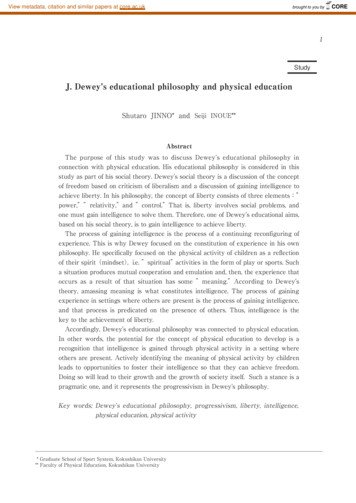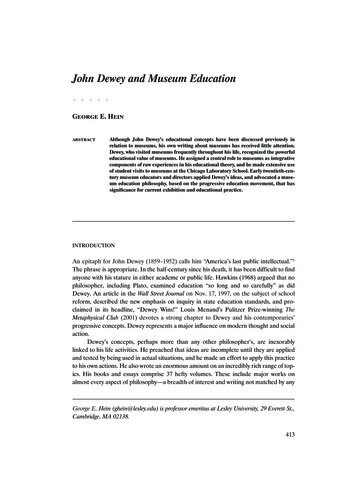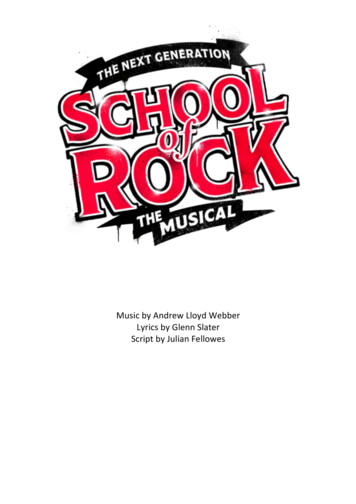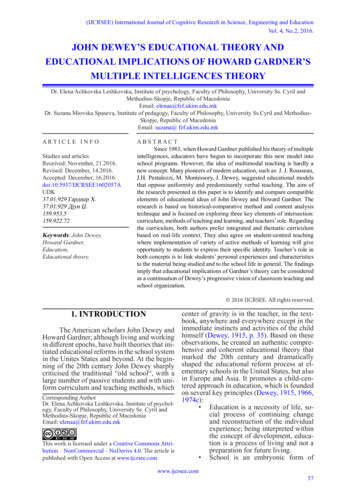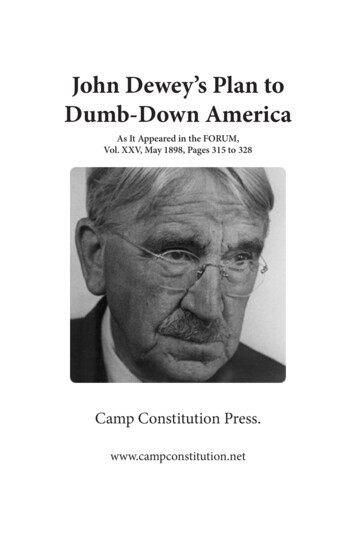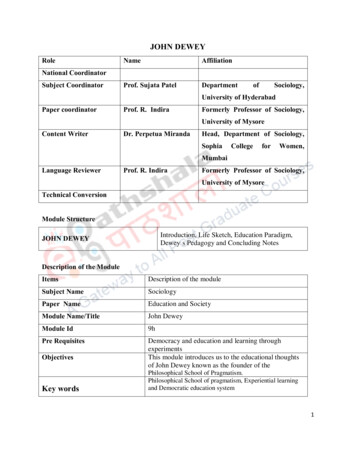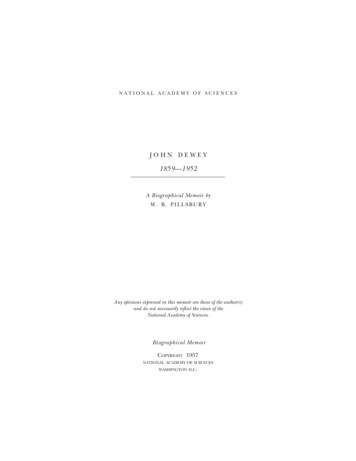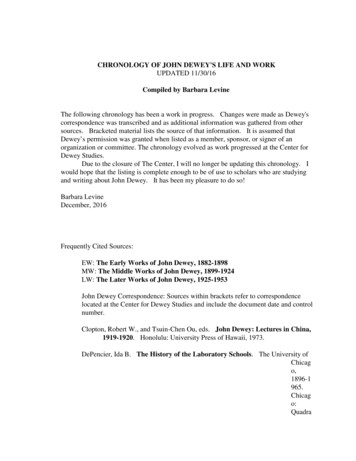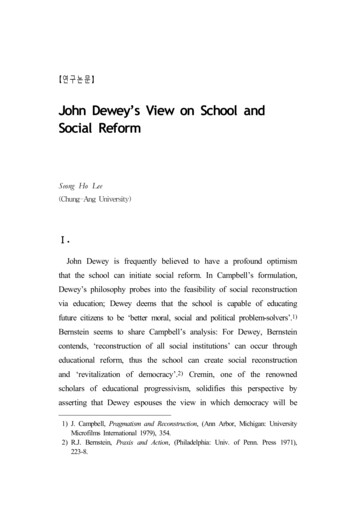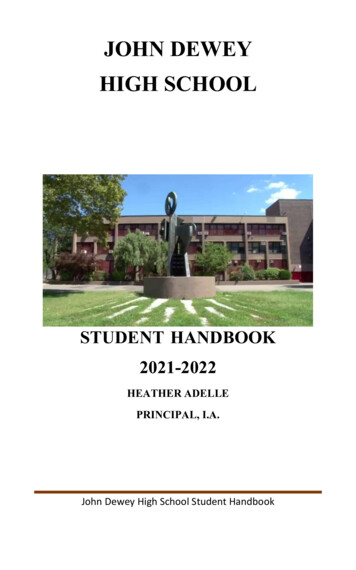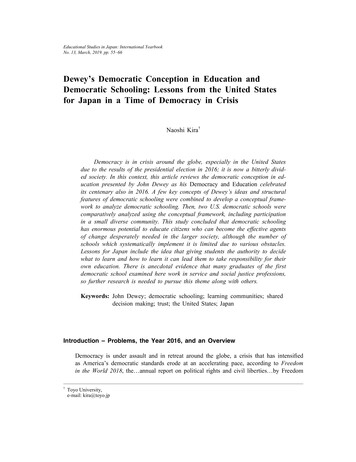
Transcription
Educational Studies in Japan: International YearbookNo. 13, March, 2019. pp. 55‑66Dewey’s Democratic Conception in Education andDemocratic Schooling: Lessons from the United Statesfor Japan in a Time of Democracy in CrisisNaoshi Kira†Democracy is in crisis around the globe, especially in the United Statesdue to the results of the presidential election in 2016; it is now a bitterly divided society. In this context, this article reviews the democratic conception in education presented by John Dewey as his Democracy and Education celebratedits centenary also in 2016. A few key concepts of Dewey’s ideas and structuralfeatures of democratic schooling were combined to develop a conceptual framework to analyze democratic schooling. Then, two U.S. democratic schools werecomparatively analyzed using the conceptual framework, including participationin a small diverse community. This study concluded that democratic schoolinghas enormous potential to educate citizens who can become the effective agentsof change desperately needed in the larger society, although the number ofschools which systematically implement it is limited due to various obstacles.Lessons for Japan include the idea that giving students the authority to decidewhat to learn and how to learn it can lead them to take responsibility for theirown education. There is anecdotal evidence that many graduates of the firstdemocratic school examined here work in service and social justice professions,so further research is needed to pursue this theme along with others.Keywords: John Dewey; democratic schooling; learning communities; shareddecision making; trust; the United States; JapanIntroduction – Problems, the Year 2016, and an OverviewDemocracy is under assault and in retreat around the globe, a crisis that has intensifiedas America’s democratic standards erode at an accelerating pace, according to Freedomin the World 2018, the annual report on political rights and civil liberties by Freedom†Toyo University,e-mail: kira@toyo.jpp055-066̲07̲Kira̲責.indd 552019/04/27 17:07:18
56Naoshi KiraHouse “Democracy is facing its most serious crisis in decades,” said M. J. Abramowitz, [its] president. “Democracy’s basic tenets—guarantees of free and fair elections, therights of minorities, freedom of the press, and the rule of law—are under siege aroundthe world”1.Democracy is in crisis around the globe. The results of the U.S. presidential election andBritain’s vote to leave the European Union (Brexit), both held in 2016, have been widelyseen as signs of the rise of inward-looking populism in a so-called post-truth era. In particular, the current U.S. administration has promoted inward-looking, America-first policies eversince its inauguration in 2017, embodied, for example, through stricter immigration policies,continuous attacks on the news media critical of the administration, etc. As a result, theUnited States is now a bitterly divided, intolerant society.The year 2016 happened to be the centenary of the publication of Democracy and Education (1916) by the prominent American philosopher, John Dewey (1859-1952) who stressedthe importance of education in a democracy. One hundred years after the original publication,this book is still well-read around the world, reflected in the fact that in 2016, there were“many conferences, special issues of journals, and book-length sets of essays on Dewey’soeuvre” (Hansen, 2017, xix)2. Importantly, Dewey was fully aware that creating and maintaining a democracy was a formidable task, and he “[made] it plain that the United States[was] not yet a democratic society” (ibid., xxi). That is why, 100 years later, “[w]hat Deweyhas to say about education, schools, teaching, curriculum, knowledge, learning, society, democracy, justice, and more, remains profoundly pertinent today” (ibid., xix).In this context, the purpose of this study is to review Dewey’s democratic conception ineducation, mainly presented in Democracy and Education, as well as to examine democraticschooling in the United States based on his and other perspectives in order to learn lessonsfor Japan. In a time of democracy in crisis, it is very important to ask how a democratic society can educate its children to become effective citizens who not only understand democracy, but also have the will to take responsible actions for it because a democracy needs to becontinuously recreated and reinvented by its members. Democratic schooling was designed tonurture such citizens, so this study explores it from Dewey’s and other perspectives alongwith actual practices. In this study, a few key concepts of Dewey’s ideas and structural features of democratic schooling were combined to develop a conceptual framework to comparatively analyze practices at two democratic schools. This study aims to learn lessons for Japan partly because democracy is in crisis in Japan too, as the current government hasundermined democracy, for example, by pushing through numerous bills without enough deliberation, and partly because traditional education is still dominant in Japanese schools despite various attempts to introduce more democratic practices.The significance of this article lies in the fact that it reviews Dewey’s democratic conception upon the centenary of his seminal work and examines practices of democratic schooling in the United States, with the understanding that democracy is in crisis, in order to drawsome lessons for Japan. In terms of research methods, it is based on an analysis of existingliterature on philosophical foundations and practices of democratic schooling.p055-066̲07̲Kira̲責.indd 562019/04/27 17:07:18
Dewey’s Democratic Conception in Education and Democratic Schooling571. Philosophical Foundations and Structural Features of Democratic SchoolingIn this section, I will review philosophical foundations of democratic schooling, put forthprimarily by John Dewey as the most prominent American philosopher presenting the democratic conception in education. There are a number of studies that review it, so this sectionwill be brief and focused on essential points regarding democratic schooling (Gutmann, 1987;Apple and Beane, 1995; Parker, 1996; Sehr, 1997; Hahn, 1998; Knoester, 2012; Noddings,2013; Stitzlein, 2014)3.In his seminal work, Democracy and Education (1916), Dewey stressed the importanceof education in a democracy with two explanations:The superficial explanation is that a government resting upon popular suffrage cannot besuccessful unless those who elect and who obey their governors are educated. Since ademocratic society repudiates the principle of external authority, it must find a substitutein voluntary disposition and interest; these can be created only by education. But thereis a deeper explanation. A democracy is more than a form of government; it is primarilya mode of associated living, of conjoint communicated experience (p. 87).As pointed out by Nel Noddings (2013), Dewey also emphasized the importance ofmembers with numerous and varied interests and of cooperative intercourse with othergroups. Dewey thus valued not only nurturing educated voters in a democracy, but also allowing students to experience democracy as a way of living together in a diverse schoolcommunity.Dewey also said of the ideal conditions of democracy and education:A society which makes provision for participation in its good of all its members onequal terms and which secures flexible readjustment of its institutions through interactionof the different forms of associated life is in so far democratic. Such a society musthave a type of education which gives individuals a personal interest in social relationships and control, and the habits of mind which secure social changes without introducing disorder (1916, p. 99).Moreover, Dewey regarded a school as “a miniature community, an embryonic society”in The School and Society (1899, p. 41), and stated in Experience and Education (1938) asfollows:A primary responsibility of educators is that they not only be aware of the general principle of shaping of actual experience by environing conditions, but that they also recognize in the concrete what surroundings are conducive to having experiences that lead togrowth (p. 40).Dewey envisioned a school as a microcosm of the larger democratic society in whichstudents and teachers learn from each other through interaction on equal terms, althoughteachers are responsible for creating a learning environment that is conducive for students’continuous growth 4. Last but not least, Dewey’s vision encompassed not just reform at thep055-066̲07̲Kira̲責.indd 572019/04/27 17:07:19
58Naoshi Kiraschool level but also transformation at the societal level, as he was a social reformer. Dewey’s democratic conception in education is thus composed of such keywords as democracy asa community life, diversity, participation on equal terms, learning community, etc.I need to mention here that although Dewey presented his democratic conception, “hefailed to fully explain how to achieve his vision” (Stitzlein, 2014, p. 61). It can be said, nevertheless, that “this fits with Dewey’s pragmatist spirit to the extent that he would not wantto pin down specific habits or guidelines outside of particular real-life contexts” (ibid.). Thisis why democratic schooling has been implemented in various forms to accommodate thespecific needs of students, staff, and community, as shown below.It should be stressed, however, that Apple and Beane (1995) distinguish democraticschools from other progressive schools that are “simply humanistic or child-centered” (p. 11).They define democratic schools as those that “seek to change the conditions that create [social inequities in school]” (ibid.). Knoester (2012) also state that “since powerful forces ofinequality and suppression exist within our society a democratic school must be aware of,and continuously thoughtful, innovative, and courageous in counteracting these forces (pp.6-7). This study uses the above definition of democratic schools that seek to influence socialchange as promoted by Dewey.Despite the variations, democratic schools need to ensure the existence of the followingthree structural features: democratic forms of school governance, classroom management, andhuman relations (Mosher, et al., 1994; O’Hair and Reitzug, 1997; Kira, 1999, 2004)5. Democratic school governance takes the forms of direct democracy in a small school (or a smallunit within a large school) in which every member is involved in shared decision making, aswell as of representative democracy in a larger school in which representatives of studentsand staff make decisions. Democratic classroom management consists of good student-teacherrelationships, student authority to make decisions, discussion-based pedagogy, etc. Democratichuman relations often mean that students can get to know each other and their teachers wellto form relationships based on trust.Behind the three structural features, the importance of small size has been emphasizedas an essential foundation for democratic schooling as it helps to build trusting relationshipsand promote personalized learning (Sizer, 1984; Meier, 1995, 2002). In fact, Meier (1995)goes so far as to state that “[s]mall school size is not only a good idea but an absolute prerequisite for qualitative change in deep-seated habits” (p. 107) and that “schools must be sosmall that governance does not become the topic of discussion but issues of education do”(p. 108).These structural features of democratic schooling are combined with the few keywordsof Dewey’s democratic conception to develop a conceptual framework to analyze democraticschooling practices in the next section. The conceptual framework consists of (1) participation in a small diverse community (human relations), (2) shared decision making (schoolgovernance), and (3) student-oriented learning communities (classroom management). Thethree aspects are closely interrelated, and democratic human relations lie at the foundation ofdemocratic school governance and classroom management (Kira, 1999).p055-066̲07̲Kira̲責.indd 582019/04/27 17:07:19
Dewey’s Democratic Conception in Education and Democratic Schooling592. Democratic Schooling in Action – Limitations and Practices at Two SchoolsIn this section, I will first mention two sets of important limitations about democraticschooling practices. I will then analyze two democratic schools in the United States using theconceptual framework developed above.2.1 Limitations and Obstacles of Democratic SchoolingI will start with limitations. First, although the democratic schooling that Dewey envisioned seems necessary as the foundation for a sound democracy, it has not been widely implemented in the United States. In this regard, Ralph Mosher, et al. (1994) express their“concern for American youth who demonstrate little concern for others,” and state that “[s]tudents have been taught about democracy, but they have not been permitted to practice democracy. Most American schools remain benevolent dictatorships” (pp. 1-2). In other words,they imply that most American schools offer the traditional, didactic mode of education inwhich students remain passive, and that the number of schools implementing democraticschooling in a systematic manner is limited, causing youth to be inward-looking. This is aperennial problem mentioned also by educators and researchers of democratic schooling, whoinstead promote more participatory, democratic approaches (Meier, 1995; Parker, 1996; Sehr,1997; Knoester, 2012; Stitzlein, 2014).Second, as the background of the first point, there are various obstacles to implementingdemocratic schooling. One obstacle is the standards-based reform that has been implementedin the United States under federal education laws since the 1990s with its emphasis on student achievement on high-stakes standardized tests and accountability, making democraticschooling harder to implement (Meier, 2003; Noddings, 2013; Meens and Howe, 2015). Another obstacle is people’s belief that democracy is for the rights of adults, and not of children (Apple and Beane, 1995, p.7). Finally, as presented above, mainstream schooling hasbeen based on traditional education, so one more obstacle is that teachers and students arenot used to instructional practices based on democratic principles.2.2 Comparative Analysis of Democratic Schooling Practices at Two SchoolsIn this study, I selected two democratic schools based on the following three criteria: (1)the school calls itself a democratic school; (2) it emphasizes Dewey’s democratic conception,and (3) there is sufficient information to analyze its principles and practices. The first schoolis a school-within-a-school (SWS) at Brookline High School (BHS) in a suburb of Bostonfounded in 1970. The second school is Mission Hill School (MHS), a pilot school within theBoston Public Schools, founded in 1997. A brief explanation of each school is presented asfollows 6:SWS consists of 115 students and staff (5 teachers and a coordinator), and its mission isto assist students to take responsibility for their own education through trusting relationships developed in a small community. SWS is an alternative democratic program established by a small group of students, teachers, and parents in 1970, when feelings ofanti-establishment were mounting During the first several years of the SWS founding,individual freedom and rights were emphasized and there was a strong, individualisticatmosphere, but in 1977, a town meeting system was established, and SWS was trans-p055-066̲07̲Kira̲責.indd 592019/04/27 17:07:19
60Naoshi Kiraformed into a democratic community. SWS practices [democratic schooling] advocatedby Mosher who was influenced by Dewey’s philosophy of democratic education (Kira,2004, p. 14).[MHS was] founded by [a prominent educator,] Deborah Meier and colleagues in1997 [and] is a small, racially and culturally integrated public pre-K-8 school usingDewey-influenced progressive education strategies and dedicated to educating studentsfor democratic citizenship. Students are admitted to the school based on a lottery, andthey graduate from the 8th grade after having produced and defended robust portfolios ofstudent work in each subject (Knoester, 2012, p.1) The school is small—only about170 students attend (41.4% Black, 27.8% Hispanic, 22.8% White.) The school isone of 21 pilot schools in Boston Public Schools, [so MHS] enjoys autonomy in governance, hiring, schedule, budget, and curriculum (ibid., p. 5).Here I will present a comparative analysis of the two schools using the conceptualframework. First, in terms of participation in a small diverse community, both schools stressthe importance of small size, but take different approaches, reflecting differences in the socio-economic status of the students they serve. SWS is a small program currently with 120125 students within BHS with its approximately 2,100 students, and the small size helps students and staff to get to know each other well and to develop the sense of community andtrust which underlays the foundation of democratic practices. SWS was originally awhite-dominated program, but students and staff were concerned about a lack of diversityand voted in town meeting in 1987 to adopt an affirmative action policy to ensure that onethird of the members are students of color and/or foreign-born, commensurate with the proportion at BHS (Bresman, et al., 2009, p. 69). As a result, SWS has become a diverse community, and students of color have also stated that they have a sense of belonging and feelsafe in the tight-knit community (Thompson and Erdmann, 1995; Kira, 1999).MHS is a small pre-K-8 school with 170 students, and the small size helps staff to getto know their students well, resulting in relationships based on trust that make democraticschooling possible (Knoester, 2012). MHS is located in Boston and has a diverse studentbody with about 70% black and Hispanic students who come mostly from low-income families in Boston.In terms of shared decision making, both schools emphasize its importance, but differ intheir approaches. SWS is a small direct democracy, where important decisions are made at aweekly 70-minute town meeting chaired by student members of the Agenda Committee (seven students and one staff member). Importantly, students and staff each have one vote, andstudents tend to learn to develop a sense of responsibility to their community as they can influence important policies at SWS 7. Students far outnumber staff, but they make responsibledecisions, and older students tend to become role models and lead the way in school governance (Kira, 1999). In addition, students’ involvement in various committees also plays an important role in assisting them to develop a sense of responsibility to their community ascommittees are much smaller in size (as in the Agenda Committee above), and hence theycan take initiatives and make a contribution more easily than in large town meetings (ibid.).By contrast, MHS is a “staff-governed” school, and “staff [as opposed to the principal inmost schools in Boston] make many important decisions together” with inputs from studentsp055-066̲07̲Kira̲責.indd 602019/04/27 17:07:19
Dewey’s Democratic Conception in Education and Democratic Schooling61Table 1: Comparisons of the Two Democratic SchoolsSWS at Brookline High School (9-12)Mission Hill School (pre-K-8)Participation in asmall diversecommunityBecame a small diverse community aftertown meeting adopted an affirmative actionpolicy in 1987 (33% students of color and/orforeign-born). There is a sense of community.A racially and culturally integrated schoolwith a diverse student body (70% black andHispanic, 23% white, etc.), and there is asense of community.Shared decisionmakingA direct democracy based on a weekly townmeeting attended by everyone in which eachmember has one vote, chaired by AgendaCommittee (7 students and 1 staff member).Staff make many important decisionstogether. It is a representative democracywith the governing board consisting of staff,parents, community members and 2 students.Student-orientedlearning communitiesIts English classes are untracked, multi-gradedemocratic learning communities. In otherdisciplines, students have less course choice.The curriculum is based on three sequentialinterdisciplinary themes and pedagogystressing five habits of mind.Sources: The studies cited in endnote (6) were used.(Knoester, 2012, p.58). It is a representative democracy, in which “[t]he governance structureincludes a governing board with the power to hire or fire the principal and set policies forthe school, consisting of one-third teachers, one-third community members, and one-thirdparents, plus at least two student representatives” (8th graders) (ibid., p. 56). MHS values thevoices of parents and community members because it is a pre-K-8 school with young children and because it seeks to be a community-oriented school.In terms of student-oriented learning communities, both schools emphasize learning communities, but take different approaches reflecting their different standings. At SWS, Englishclasses best represent democratic learning communities, as they are untracked, multi-gradeclasses where teachers lead, but “seniors [old-timers] model, teach, and inspire others”(Bresman, et al., 2009, p.70). SWS students have a say in choosing those English and humanities courses, as they vote on them for the upcoming year after discussion on the classesproposed by teachers. “In other disciplines, such as math, science, and social studies, studentshave less course choice because of state and local graduation requirements” (ibid.). Althoughthey benefit from numerous course offerings at BHS, a lack of autonomy in the curriculum isa disadvantage of being part of a large public school.By contrast, MHS is a pilot school with extensive autonomy, reflected in its main curriculum and pedagogy. Its curriculum is “framed under an umbrella of three sequential wholeschool interdisciplinary themes each year [and] the thematic units are offered on a 4-yearrotational basis [so that] students experience learning within these themes twice” (Knoester,2012, p. 78). “[T]he central focus of the curriculum is the development of five habits ofmind, useful for effective democratic participation and deliberation, as well as in the academic disciplines” (ibid., p. 72)8. Moreover, “[a]ll classes are multi-aged [without] tracking,”(ibid., p. 76) and students engage in meaningful learning in diverse learning communities.These two features allow teachers to provide students with coherent learning experiences atMHS. Table 1 contains the summary of the comparative analysis of the two democraticschools based on the conceptual framework.Several limitations as well as positive aspects of democratic schooling are presentedabove, but there are also difficulties at the school level. First, democratic schooling is ap055-066̲07̲Kira̲責.indd 612019/04/27 17:07:19
62Naoshi Kiratime-consuming enterprise, and students and teachers may find it inefficient and frustrating attimes. Students at SWS find some town meetings boring or tiresome as there are routine issues to be discussed, and discussions often drag on (Kira, 1999). Teachers at MHS may feelthat they are pressed for time as they regularly have to attend faculty meetings for shareddecision making in their busy schedule (Knoester, 2012).Second, these schools also have to deal with difficult trade-offs between financial stability and autonomy. The two schools are both public and have the financial stability to survive,but in return, they also have to give up some autonomy. SWS is an alternative program in alarge public high school, which has survived for almost 50 years with the support of the administrators. Although SWS has enjoyed the autonomy in governance to assist its participantsto practice democracy, it has to make compromises, for example, in curriculum in terms ofcourse offerings and contents due to being part of a large public school 9. Although MHS isa pilot school in Boston and enjoys extensive autonomy, “the mayor and City Council made plans to move [it] into a different school building and community” in 2012 despitemulti-level protests (ibid., p. 67). These accounts show the difficult trade-offs encountered bythese public democratic schools, with no easy solution.3. Lessons Learned from the United States for JapanIn this section, I will draw some lessons on democratic schooling from the United Statesfor Japan. Based on the analysis presented above, two lessons can be learned.First, when learning takes place in small diverse learning communities where studentshave a say in what to learn and how to learn it in order to connect their learning to theirlives and experience, they tend to start learning for themselves and taking responsibility fortheir own education. In addition, when students are given ample opportunities to learn fromone another, they tend to develop a sense of community and belonging. These things happenmore easily in smaller classes where there are trusting relationships among members.In Japan, the traditional, lecture-based instruction still dominates for the fulfillment ofthe national Courses of Study as well as for the preparation of entrance examinations. As aresult, many Japanese students do not have a sense of ownership of their learning 10. In thiscontext, the new national Courses of Study to be implemented from 2020 onward promoteself-directed, dialogic, and deep learning which can help students learn on their own and collaboratively. One major caution is not to go to the other extreme of letting students do whatever they want, from the prevailing extreme of giving them almost no authority in what tostudy and how to study it, as Dewey pointed out in The Child and the Curriculum (1902),Experience and Education (1938), etc.Second, when students can make and modify school rules, or at least when their voicesare heard and respected, they tend to feel empowered and to start thinking about how to improve their school, while taking responsibility for abiding by the rules that they helped tocreate. This happens more easily in a small school where there are good relationships between students and teachers, and students develop a sense of belonging and responsibility. Aswell, the sense of responsibility to their community—an important feature of democratic citizens—is often carried on after graduation, as SWS staff members write:p055-066̲07̲Kira̲責.indd 622019/04/27 17:07:19
Dewey’s Democratic Conception in Education and Democratic Schooling63Our record of college acceptance looks very much like that of its host school—one ofthe most competitive —yet our graduates often choose to devote their lives to community service, teaching, and further education after college. As Bob Weintraub, principalof [BHS] observed: “One of the characteristics of SWS graduates is so many of themwork in service and social justice professions. That is not an accident. The culture ofSWS builds a sense of responsibility to [their] community. They live that ethic in schooland carry it with them into the wor[l]d of work” (Bresman, et al., 2009, pp. 68-69).This is an extremely important aspect of democratic schooling to be emphasized in the faceof democracy in crisis.In Japan, school rules are usually imposed on students without much explanation, leaving them to feel either helpless or antagonistic. A major problem with this practice is thatstudents become passive recipients of rules, without any experience of making and modifyingrules, rather than active agents of change. What is needed is not a sudden change, but agradual transition to giving students some authority to modify school rules within an institution of representative democracy, such as student councils, in order to improve their schools.Conclusions and Future Directions for ResearchOver 100 years ago, Dewey envisioned schools as microcosms of democratic society inwhich students experience democratic ways of living together in a small community to helpthem become effective agents of change. Democratic schooling has been operationalized inmany ways. Based on the examination of the two democratic schools, this article concludedthat democratic schooling has great potential to educate citizens who can become effectiveagents of change, although the number of schools which systematically implement democraticschooling is limited. There are also a variety of practices in the areas of education for democratic citizenship, education for civic engagement, etc., conducted at schools with or withoutconnections with local communities to revitalize democracy, which are not included in thisstudy 11. The limitation of this study is that it focused on democratic schooling with the threeafore-mentioned criteria.Here I will point out two areas of research needed in the future. One area is further research on democratic schooling in terms of its details. For example, research is needed onadmission policies and student characteristics. Students are often selected through a lotteryamong those who want to join the school, but can democratic schooling work for studentswho have not made this choice? Research is also needed on the trade-offs between school financial stability and autonomy. The ultimate question is how to maintain long-lasting and autonomous democratic schools.Another area of research is a tracer study of graduates of democratic schools includingtheir professional lives. There is some evidence that democratic schooling is also an effectivemeans of academic preparation in that students move on to college at a rate much higherthan the norm especially among those from low-income families at MHS. As for the professions of graduates of democratic schools, however, there is only anecdotal evidence thatmany SWS graduates work in service and social justice professions as presented above. So,systematic research is needed to clarify the impact on g
Moreover, Dewey regarded a school as “a miniature community, an embryonic society” in The School and Society (1899, p. 41), and stated in Experience and Education (1938) as follows: A primary responsibility of educ
